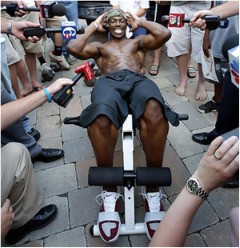CP Intern Blog by Conor Nordengren: Up the “Ab Ante”
Today’s guest blog comes from current Cressey Performance intern, Conor Nordgren.
We’ve all heard those stories about the training regimens of celebrities and how they do 500 crunches first thing in the morning and 500 more right before bed to get that perfect six-pack of abs. Many of you have probably also seen that infamous video of T.O. performing crunches while conducting an interview with reporters.
While exercises like crunches and sit-ups can bring out those abs and sculpt a nice six-pack, is this the safest method to train the core? Top strength and conditioning coaches like Eric Cressey, Tony Gentilcore, Mike Robertson, Mike Boyle, and Jason Nunn have recently written and talked on the subject and say that it is not.
As an intern at Cressey Performance, I’ve been exposed to a ton of programs and not a single one of them has included a crunch or a sit-up. Here’s why:
If you’re familiar with Mike Boyle’s joint by joint approach to training, you know that the lumbar spine requires stability as opposed to mobility. Think about the execution of a conventional sit-up: what is your lumbar spine doing? That’s right, it’s flexing. The lumbar spine is not designed for a great deal of movement (whether it is flexion or extension), let alone repetitive movement. Our spine as a whole is not meant for a ton of flexion or extension, either. While you may “feel the burn” in your abs when performing a set of crunches, you are essentially training spinal flexion. World-renowned low-back researcher Dr. Stuart McGill says that we have a finite number of flexion/extension cycles in our back until injury is caused. That number is different for every person, but the bottom line is that by performing exercises like crunches and sit-ups, you’re increasing your risk for injury with every rep! Dr. McGill has actually done experiments where he’s put pig spines in a crunch machine and after a certain number of crunches, or flexes, spinal disks explode.
Crunches and sit-ups also promote a kyphotic, or rounded back, posture. Visualize someone in the top position of a crunch or a sit-up. Now, keep that visual of their upper-back, but picture them standing up. Hello Quasimodo!
Would you consider this good posture? Of course you wouldn’t (well, hopefully not). So why would we want to reinforce it?
James Porterfield and Carl DeRosa have written that the core musculature is primarily designed to transmit force, not to produce it. While crunches and sit-ups are promoting flexion of the spine, our core should instead be trained in preventing movement. If we train our core to be rigid and prevent movement, the stronger it will be; this translates to more overall force production throughout the whole body which will allow for bigger lifts. Sounds pretty good, huh?
Thanks in large part to Mike Robertson, we’ve been introduced to four acceptable movement patterns that should be utilized when training the core. They are anti-rotation, anti-extension, anti-lateral flexion, and hip flexion with a neutral spine. While there are several variations of the following exercises, here are some of my favorites:
Anti-rotation: Tall Kneeling Pallof Press – the kneeling version really forces you to use your glutes and your core, since your quads are taken out of the picture (this exercise can also be done on a cable machine).
Anti-extension: Ab Wheel Rollouts – progress to band-resisted or off of a box for added difficulty.
Anti-lateral flexion: Waiter Carries – can also be done with a kettlebell.
Hip Flexion with a Neutral Spine: Prone Jackknifes with a stability ball – you may find this to be one of the more challenging movements, so really focus on keeping that core tight!
Some of you may have a hard time imagining your workout without any crunches or sit-ups. You might be skeptical that the above exercises may not get you the results that you desire. Well, Tony “The Situation” Gentilcore performs these movements on a regular basis, and when he voluntarily and superfluously flashes his abs at us interns every day, let me tell you, I could wash my clothes on those things! But seriously, change is hard and not an easy thing to accept. However, the good thing about change is that it can be for the better. I’m not demanding that you immediately stop performing crunches and/or sit-ups; that choice is yours. It’s my hope that you think about how you’re currently training your core and ask yourself if this is the most optimal, functional, and above all else, SAFEST way to do so. This may help to keep you injury-free down the road so you can continue hitting the iron hard.
Conor Nordengren can be reached at cnordengren@gmail.com.
Sign-up Today for our FREE Newsletter:




